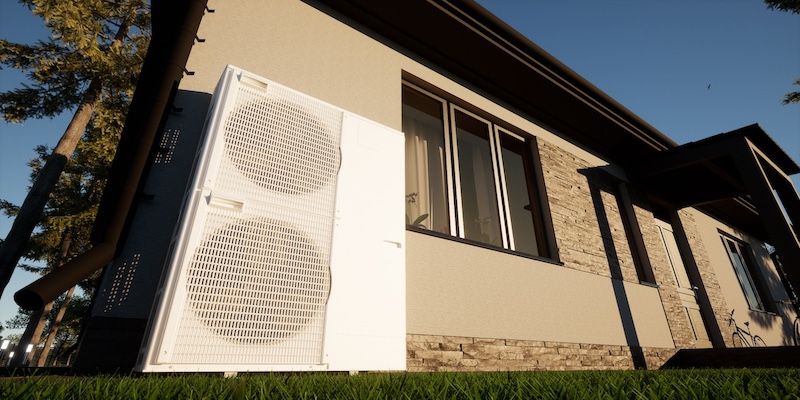
Simon Buddle looks at the control of heat pumps for heating and cooling, and how KNX installers can add the benefit of cooling at little or no extra cost.
It has been quite a few years since the heat pump first appeared on the market. I then recall plumbers suggesting that it may well be time for them to retire rather than getting involved in all this new-fangled technology. At the time, the biggest single issue was that heat pumps could not achieve the temperature levels required for the domestic hot water supply of 60C. The separate issue of how to get a boiler and heat pump working in harmony was little more than a 3-port valve and some logic. If you knew the heat pump’s maximum temperature, it was straightforward to then swap to the boiler to get you the rest of the way to 60C, or even to use the immersion heaters if there was no boiler. But it is true to say that the words ‘heat pump’ struck fear into the hearts of many a plumber.

Current heat pump capabilities
Roll forward almost ten years and they are being installed as the default heat source. The problem with lack of capability for hot water is outdated, and for many manufacturers, they now have a fully-featured controller that runs the heating and cooling for the average house. That assumes, of course, that the house only requires one thermostat and a single cylinder. Many of the houses we service have much more complex needs.
Cooling
Another step forward for heat pump technology is the ability cool as well as heat. The process is the same, only in reverse. So rather than pulling heat from outside and moving it into the house, the heat pump pulls heat from the house and shifts it to the outside. In our world, this means driving cold/cooler water around the underfloor heating loops. It is a straightforward process, but it does require a little more thought than ‘heating only’.
General principles
I view heating control as a simple hierarchical pyramid with the room temperature controller at the bottom. For each manifold, we get a demand signal based on the rooms connected to it. This then creates several demand signals that generate a single global heat demand signal. That in turns drives on the boiler and associated plant to send heat to the rooms. I am sure that all of this is well known to most.
With a heat pump in cooling mode, the process is identical except for two crucial elements:
1) Cold is needed not heat.
2) A heat pump can only deliver heat or cooling, not both simultaneously.
When the heat pump is a complete packaged system and has a single thermostat such as in a standard home configuration, there is nothing to worry about. However, when we come into the more complex world of a KNX home, we need to take a little care on how this is accomplished.
KNX solution
The most pertinent point here is that we are going to need some logic. Thermostats can output both heating and cooling signals. But when one is ON, the other must be OFF as they cannot both be true simultaneously. As the heat pump can only be in one state or the other, it would seem to make sense to use a summer/winter function activated by the client or time of year, to signal switchover for the heat pump. The logic comes in when we need to run the heating system without heat by opening the manifold valves, running the local pumps, and opening any 2-port valves to the manifold. The logic is required so that we can open the valve if there’s heating demand, or in summer mode, cooling demand. It requires a simple OR gate on the valve to enable it to work.
This is a new(ish) development in the world of heating/cooling that requires a little more thinking on our part. It may also require manufacturers to add the OR gate to their heating controllers so that we can do this in a simple and robust way. Zennio and ABB for example, have logic built into their actuators, but not all manufacturers do, so be careful when choosing products.
Sensing humidity
Installing temperature sensors into the floor to provide an overheat alarm so that we can protect floors from damage has been the defacto installation method for years. Many of those same devices can also protect against over cooling, but what they might not do is provide the dew point – the point at which air becomes saturated with water and droplets begin to form. This may be equally disastrous for the floor, whether wooden or covered by carpets. The dew point is dependent on room temperature and humidity, both of which vary.
For further reading, see HVAC: the importance of humidity to KNX installers.
Conclusion
We are, as always, wonderfully placed in the KNX world to control complex systems. The advent of heat pump technology provides us with yet another opportunity to say to our customers, ‘Yes, we can help you with that.’ Remember, they were already buying all the controls to operate the heating, so when you consider that the only real addition to the system to facilitate the cooling is a small piece of logic, it feels like we have given our client a massive benefit at little or no extra cost.
Simon Buddle CEng MIET, is a consultant for Future Ready Homes, a specialist in BMS and ELV services system design.












